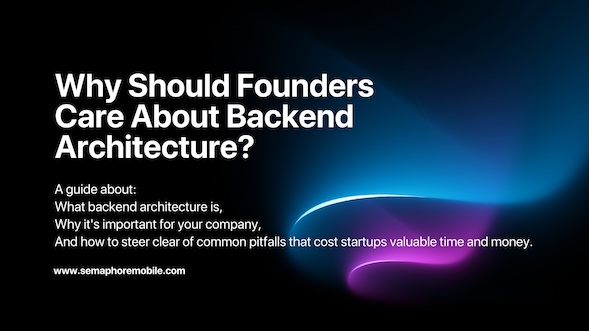
Why Should Founders Care About Backend Architecture?
Introduction
The backend of an application frequently seems like a mysterious, hidden, and “someone else’s problem” to many non-technical startup founders. The reality is that you cannot afford to overlook your backend architecture if you are serious about creating a successful, scalable product.
It establishes the speed at which you can launch, the ease with which you can scale, and the short and long term costs. Understanding the main backend options can also help you make quicker, more informed, and more economical product decisions even if you don’t need to write code.
This guide explains what backend architecture is, why it’s important for your company, and how to steer clear of common pitfalls that cost startups valuable time and money.
What Even Is “Backend Architecture”?
Everything that your users depend on each time they use your product but cannot see is called the backend. It consists of servers that handle user requests, databases that hold the data for your app, authentication systems that protect user information, and APIs that facilitate communication between the front end and back end.
The structure, hosting, and interactivity of all these elements are referred to as backend architecture. Similar to building a house, the foundation, wiring, and plumbing are the backend. Although invisible, it controls whether the house withstands stress or collapses.
High performance and uptime, modular code for simpler updates, flexible integration with new features, and predictable and optimized infrastructure costs are all guaranteed by good architecture. On the other hand, poor architecture results in costly rework or complete rebuilds, slow development and launch delays, high server and maintenance costs, and exhausted engineering teams.
Backend Choices Founders Should Know
1. Monolithic vs. Microservices vs. Serverless
The purposes of various backend styles vary. This is how they compare:
- Monolithic Architecture
Your entire application is bundled into a single, tightly integrated codebase by a monolith. MVPs prefer it because it is quick to develop and simple to launch. However, scaling and maintaining your app gets more difficult as it gets bigger. Updates may inadvertently cause other app components to malfunction. - Microservices Architecture
Microservices divide the backend into discrete, standalone services, such as notifications, payment processing, and user login. Because teams can build and deploy independently, this modularity is perfect for scale. However, it is frequently overkill for early-stage products and adds upfront complexity. - Serverless Architecture
Serverless uses cloud functions that run only when needed. It eliminates the need to manage servers and is ‘pay as you go ‘, making it ideal for lean startups but it comes with limitations in terms of long running tasks and complex workflows.
For most MVPs and early stage startups, a serverless or lightweight monolith offers the right balance between simplicity, cost, and speed. You can always evolve into microservices later.
2. APIs: The Nervous System of Your App
APIs are the glue between your frontend and backend. They determine how user inputs (like clicking a button) are translated into actions on the server.
- REST APIs are the most common and widely supported.
- GraphQL APIs provide more flexibility, especially when your frontend needs customized data.
The quality of your API design influences how quickly new features can be built, how smoothly integrations (like payments or analytics) are added and how easy it is for new developers to onboard.
A poorly planned API leads to messy data flows, duplication, and fragile integrations. A good API acts like clean, documented wiring in a building easy to understand, change, and extend.
3. Infrastructure: Cloud Isn’t Just a Buzzword
Every backend needs a home and that home is usually in the cloud. Choosing the right cloud provider and setup early on has huge implications,
- AWS offers vast capabilities but can be complex to manage
- Google Cloud (GCP) is developer friendly with strong AI/ML tools
- Azure integrates well with Microsoft ecosystems
You’ll also need to decide on
- Database types (SQL vs. NoSQL)
- Deployment tools (Docker, Kubernetes, etc.)
- Monitoring & logging systems
At Semaphore we help startups choose infrastructure that fits their size, product type, and growth goals without overengineering or overpaying.
How Backend Architecture Affects Business Outcomes
1. Speed to Market
You can have the best idea in the world, but if your backend is messy, slow, or brittle, you’ll burn weeks or months on fixes rather than features.
- Startups need iteration velocity, the ability to ship, test, and refine quickly.
- Backend bloat, unclear architecture, or legacy decisions slow everything down.
2. Scalability & User Growth
A spike in users is a great problem unless your backend can’t handle it.
- Poorly designed systems crash under load
- Data bottlenecks cause lag and downtime
- Scaling manually means more DevOps, more bugs, and more spend
Smart backend architecture ensures performance remains smooth whether you have 100 users or 100,000.
3. Developer Experience & Cost
Messy architecture leads to slower dev onboarding, frequent bugs and regressions and more developer hours is more money.
Clean architecture with clear documentation means happier developers, fewer bugs, and lower long term costs.
What Founders Should Ask Their Tech Team (or Partner)
You don’t need to understand every acronym buut you should ask,
- “Why was this architecture chosen?”
- “How well does this scale as we grow?”
- “Is it easy for other devs to understand and contribute to?”
- “What’s our biggest technical risk right now?”
If the answers sound vague or overly complex, that’s a red flag. A strong tech partner should be able to explain clearly, not just code confidently.
How Semaphore Helps Startups Build Smart from the Start
Semaphore isn’t just another dev shop, we’re a strategic partner that aligns technology with business goals.
Here’s how we help:
- Serverless first MVPs: Lean, fast, and scalable from day one
- API first thinking: Build for today, prepare for integrations tomorrow
- Cloud native deployments: Optimize for cost, security, and scale
- Ongoing architectural reviews: Catch issues before they become emergencies
Whether you’re launching a prototype or prepping for Series A, we make sure your backend is a strength, not a risk.
Frequently Asked Questions (FAQs)
Why should non technical founders care about backend decisions?
Backend decisions affect time to market, budget, and scalability. You don’t need to know how to code, but you do need to ask the right questions or partner with someone who can translate tech into strategy.
Is serverless architecture always the best for startups?
No architecture is one size fits all but for many startups, serverless hits the sweet spot: low cost, low maintenance, fast to build. It’s ideal for early validation.
How do backend choices impact product market fit?
Startups need speed and flexibility to test ideas. The wrong architecture can slow you down, preventing you from finding and adapting to what users actually want.
Can bad backend architecture really cost more?
Yes, through hidden costs like slow development, higher developer turnover, infrastructure waste, and expensive rewrites.
What are red flags to watch for in backend proposals?
- Too much jargon, not enough clarity
- Overengineering for an MVP
- Lack of documentation or handoff plans
- No consideration for future growth
When should I consider rebuilding backend architecture?
If your app is constantly crashing, hard to update, or your team is stuck firefighting, it may be time for an architectural design ideally before you scale.
Conclusion
You don’t have to be technical to care about backend architecture but you do have to care. It’s not just a developer concern, it’s a business critical decision that influences speed, scale, and success.
Founders who understand the backend at least enough to ask the right questions can lead better, launch faster, and avoid painful rebuilds down the road.
Ready to make smart backend choices? Semaphore is here to help you build fast, scale smart, and stay lean from day one. Our clients range in size from the large to the small. Let us know how we can help you. Drop us a line today and let’s start talking about your business.
What Are You Waiting For?
Copyright © 2021 Semaphore Mobile. All Rights Reserved.




Let us know your thoughts!